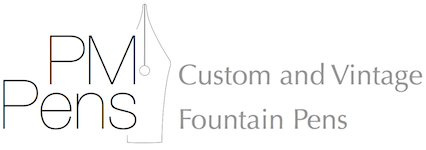Modern Flex from Fountain Pen Revolution
A friend recently asked me to make him a pen with a flexible nib, capable of being used for writing copperplate. I have tried putting Comic G dip-pen nibs in fountain pens in the past. This works well, however, the pen requires a lot of maintenance. This is because these nibs are not made for fountain pens, and will start to corrode badly if not cleaned and dried when not being used for a couple of days.
So, the search was on for a flex nib that could be used in a custom fountain pen. After some digging around on the ‘net I came across a company in Texas called Fountain Pen Revolution, a family-owned business run by Kevin Thiemann that claimed to offer high-quality pens and nibs at reasonable prices. “Worth a try” thought I, so I placed an order for their #6 Flex Two-tone nib.
After getting hung up at Danish customs for a day or two, the nibs arrived today, so I put one in my daily-use pen, which normally has an extra fine Bock nib in it.
Initially, the nib was very flexible, (their website states a line variation from 0.4 mm to 2.0 mm in width), but scratchy. There was some mis-alignment of the tines that took a little fiddling to correct. Following this, a little sanding was needed to do the final smoothing (see Richard Binder’s tutorial on the care and feeding of nibs for a good source of info on this…).
The result is very good. Below is a quick sample I did to compare the nib (in a “normal” feed, which occasionally approaches railroading…). This was done on a Mnemosyne Light pad from Maruman (N172) using Pelikan 4001 ink. For the comparison, I used the same ink (albeit a different colour) in three other pens, (a Danish Montblanc 206, a German Matador Junior 004, and a Danish Hoover 883), as can be seen there.

I’ll test drive the nib for a couple of days to see how it feels over time – but it seems that I’ve found the solution… Next time, however, I’ll have to order more nibs in the same shipment to make the Danish customs fees worth it (they have a flat fee for processing that, in this case, was about 4 times the actual cost of customs…)
Thanks Kevin!
